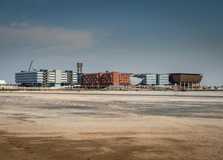Masdar City / Abu Dhabi
Desert bloom
Located geographically and aesthetically far from famed Emirati excess, the €12bn Masdar City project is trying to plot out a new urban vision. But taking root in the desert has proved difficult: so far just 300 people live in the “city”.
It would be easy to miss Masdar City wherever it was. Via a sun-dazzled squint from a distance, it looks like a modest, modern industrial estate, a densely packed huddle of apparently windowless buildings perched in the wastelands neighbouring an airport. Up close the architecture is more intriguing: a modernist take on a traditional terracotta kasbah blended surprisingly gracefully with the silver cubes of a lunar base. The overall effect suggests the set of a science-fiction remake of The Battle of Algiers. But it is still tiny: every inch of Masdar City’s streets can be strolled in under 20 minutes. And it’s weirdly quiet; an Arabian city – though “city” is pushing it – in which you can’t hear any car horns.
It is especially easy to miss Masdar City amid the Brobdingnagian hubris of the rest of Abu Dhabi, a city that appears to have not yet been presented with an idea it thinks too expensive, ostentatious, gauche, decadent or silly. But even measured against the Formula One track, Ferrari theme park, world’s most-leaning skyscraper, world’s eighth-largest mosque, what was once the world’s tallest flagpole, a hotel called the Emirates Palace that makes most actual palaces look like hotels and the soon-to-open local franchises of the Guggenheim and the Louvre, Masdar City may be the most ambitious enterprise in town. Masdar City is – or at least is supposed to be – the future, no less.
“It’s maybe 10 per cent finished,” says Anthony Mallows. The South African architect and city planner, 65, is director of Masdar City. “But it will double in size in the next three years and will be substantially complete by 2030.”
Mallows is not an elected mayor. He is an employee of state-owned renewable energy firm Masdar – and part of his job is to run Masdar City at a profit. But, like a canny politician, he is managing expectations. When work began in 2008, the accompanying rhetoric was expansive even by the standards of the region. By 2016, it was proclaimed, this would be home to 50,000 people and 15,000 businesses, with a further 40,000 commuting workers all rejoicing in a solar-powered, carbon-neutral, zero-waste, car-free, eternally sustainable Utopia.
Reality, in the shape of global recession, intervened. So with a year or so to go before that ballyhooed deadline, Masdar City is inhabited full-time by about 300 of the 491 students attending the Masdar Institute, a hub for sustainability research. Masdar City is, as things stand, rather more Masdar Hamlet. There are few people on the streets and visible commercial activity amounts to a a couple of cafés and shops catering to students and staff of the Institute (the recent opening of a Mexican restaurant is a great leap forward on the nightlife front). But there is also – somewhere, we’re assured – a 2,000-strong workforce that includes the 800-plus employees of Siemens, which opened its Sheppard Robson-designed Middle East headquarters here in January 2014, as well as those toiling for the 173 companies operating in Masdar City’s Incubator Building (these include GE, Mitsubishi and Grundfos among others, taking advantage of the Masdar City Free Zone).
All of this is undeniably impressive. But the UAE government’s initial commitment to Masdar as a whole was €12bn – about the 2013 GDP of Iceland – for which they so far have something that you could, with a following breeze and at some risk to the rooftop solar panels, smack a golf ball over.
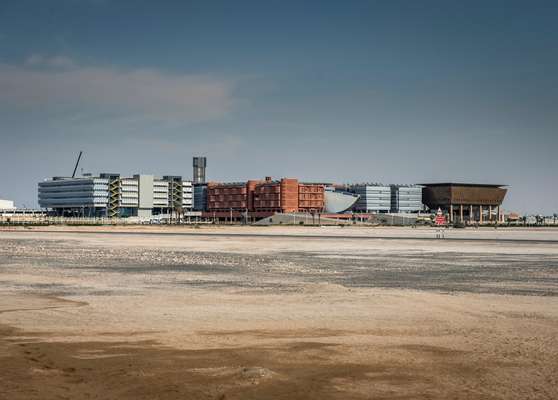
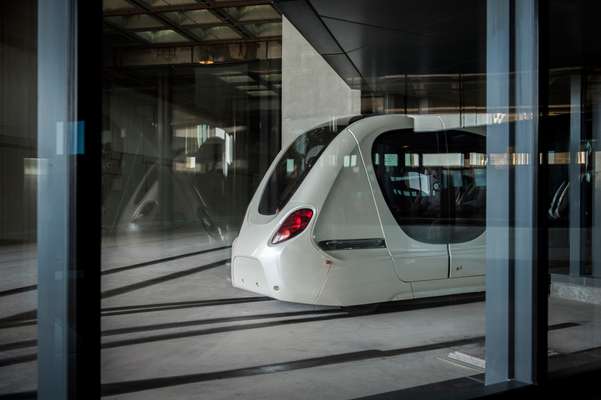
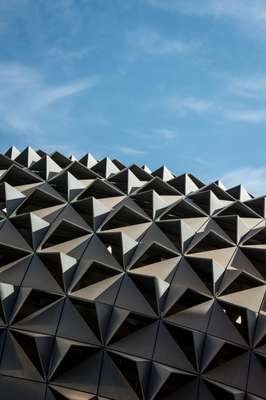
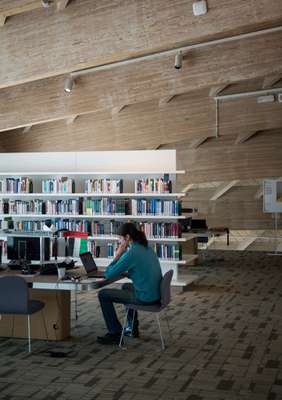
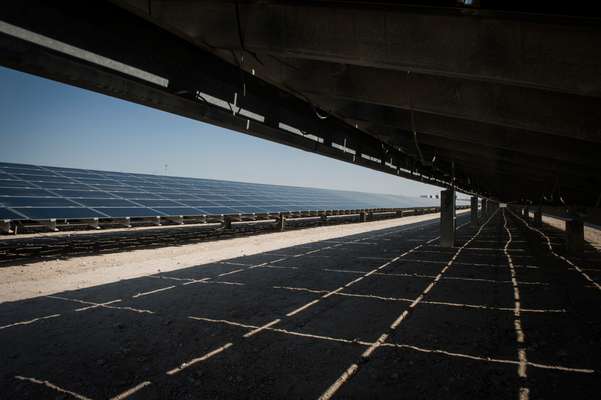
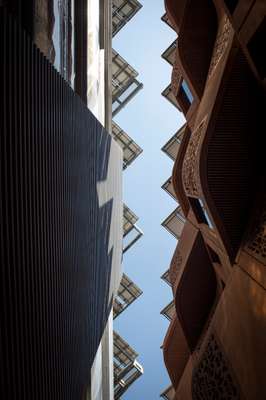
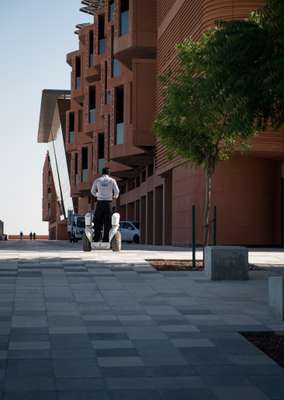
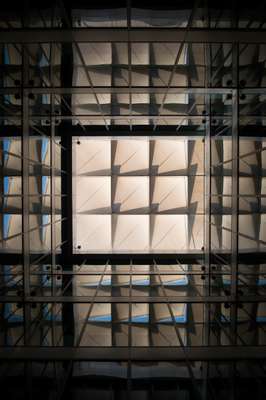
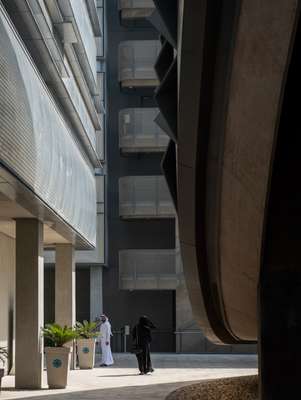
“There has been no cutback in size,” says Mallows, “and no cutback in government commitment.” He spreads a colour-coded map on the café table, pointing out the planned new neighbourhoods and the locations of such future developments as a Hilton hotel, the Abu Dhabi Science Centre and the Emirates College of Technology. But such things do not, in and of themselves, make a place attractive to live in. Masdar City currently suffers from a smaller version of the bigger drawback of Abu Dhabi as a whole, which is that it lacks, for want of a less corny phrase, a soul: it’s doubtless a profitable place to work in, but it’s hard to imagine anyone dreaming wistfully of living there. Mallows acknowledges that Masdar still needs “an urban identity, a sense of place” but notes that any city built around students often has a head start on that front. Masdar City could be, Mallows insists, a great university town like Cambridge, Oxford or Stanford, as well as a laboratory for sustainable living.
The project’s initial designers, UK architecture firm Foster + Partners, rejected the preening vernacular of Abu Dhabi, understanding that while shimmering glass mountains and broad tarmac boulevards may look impressive to tourists, they are not the most hospitable or economical places to spend 45c summers. Masdar City is a throwback to centuries of more austere Arab architecture, the streets narrowed to create shade and oriented to funnel such wind as there is; it is, on average, 10c cooler here than elsewhere in Abu Dhabi. Modern materials have been applied to ancient principles: the rust-coloured accommodation blocks are made of glass-reinforced concrete; the aluminium-coloured Institute buildings are ethylene tetrafluoroethylene, a plastic that doesn’t radiate heat. Masdar City is also very pretty.
“We looked a lot at how cities have always been built in the Middle East,” says Briton Chris Wan, Masdar City’s design manager since building began. “You realise that they don’t just look beautiful: the thick walls, small windows and narrow streets do a great job of keeping the sun out. So the aesthetics are derived from the response of the buildings to the environment.”
But is the Masdar City ideal exportable or is it only going to work where you have large areas of utterly unused land and even larger reserves of cash? “If you took our blueprints and stuck them on your own country, I can absolutely guarantee that it wouldn’t work,” says Wan. “But the philosophy will; the questions you have to ask, the fundamental principles you have to work by, are exactly the same.”
“This would be the worst thing you could do in Copenhagen,” adds Steve Severance, 47, Masdar City’s Californian manager of programme management and investments. “We’ve built to increase windflow; they do everything to reduce it. We try to keep the sun out, which I’m not sure they’d appreciate in Denmark. And we have slowed it down. The original statements were very ambitious, all ‘Build it and they will come’, but it makes more sense block by block.”
The signature attraction thus far is the project’s embryonic public transport network. The PRT (Personal Transport System) is a subway of driverless electric cars operating beneath Masdar City, which perches on a raised podium above (new areas will be built at ground level, however). The cars, resembling four-seater steam irons, were conceived by Italian sports-car designer Zagato and built by insufferably named Dutch tech company 2getthere.
Like much else here, the PRT has been scaled back: what was supposed to be a fleet of 3,000 vehicles zipping betwixt 100 stations is currently 10 prototypes trundling the 800 metres between the Institute and Masdar City’s car park. It is, however, weirdly addictive, possibly for the realisation that the safest your correspondent has ever felt in a car in the Middle East is in one which doesn’t have a steering wheel.
On one of our gratuitous PRT commutes we share a ride with Noura al-Wahshi, 27, studying microsystem engineering at the Institute. “The whole of the UAE is starting to have issues with crowded streets, traffic jams, accidents,” she says. “So maybe we can help make people less keen on using cars to go places.”
This raises the question of how seriously one can take an environmental revolution commanded from a country that, according to the World Bank, is the world’s eighth-worst per capita perpetrator of carbon emissions. “It is a hugely counterintuitive idea,” says Adnan Amin, the 50-year-old director general of the International Renewable Energy Agency (Irena) – the presence of which in Abu Dhabi feels as surprising as stumbling across a Lamborghini showroom in Amish country. “When I first heard about Masdar City I thought it was a palliative, or a flash in the pan from an oil-rich country but the more I heard the more I realised they were serious.”
The people associated with Masdar who seem least startled by the idea of a UAE transition from hydrocarbon giant to clean-energy pioneer are the Emiratis. Bader al-Lamki, 40, is Masdar’s director of clean energy. As he observes, Abu Dhabi today is vastly different to the Abu Dhabi of his childhood and utterly unrecognisable from the place his father grew up in. Things can change fast around here – as his own career path did.
“I studied chemical engineering and worked in oil and gas for 11 years,” he says. “But oil and gas will decline. We need to establish expertise in clean energy to position this country as a continuing player.”
That edge of blunt realism may be the project’s most solid guarantor of success. Idealistic it may be, but Masdar City isn’t the doing of suddenly penitent lottery winners atoning for a profligate spree: it’s a bulwark against decline built by people who have come to enjoy power and wealth, and have no interest in losing it.

